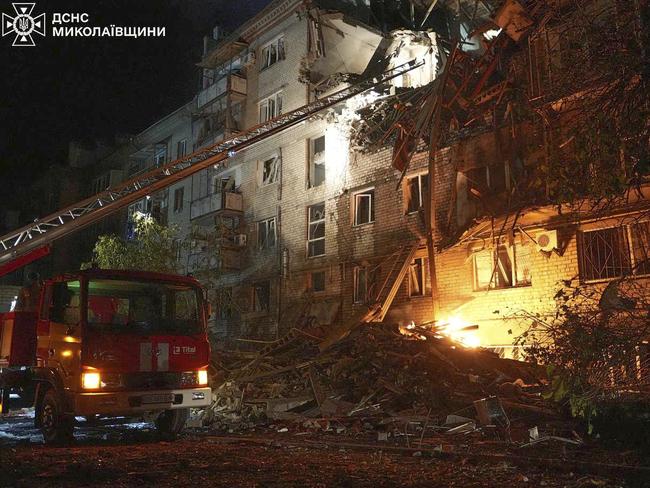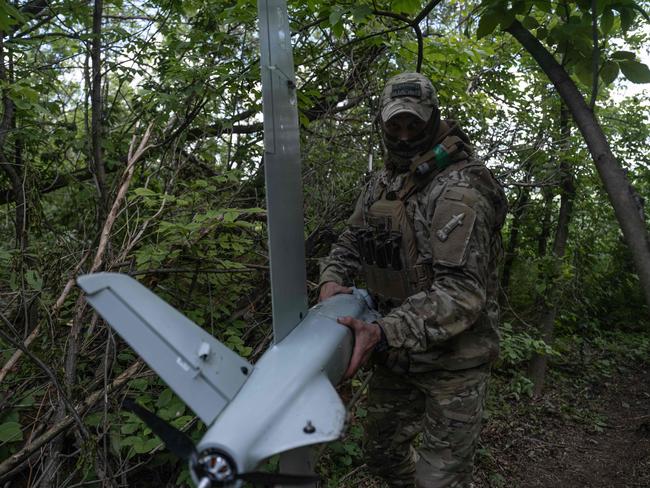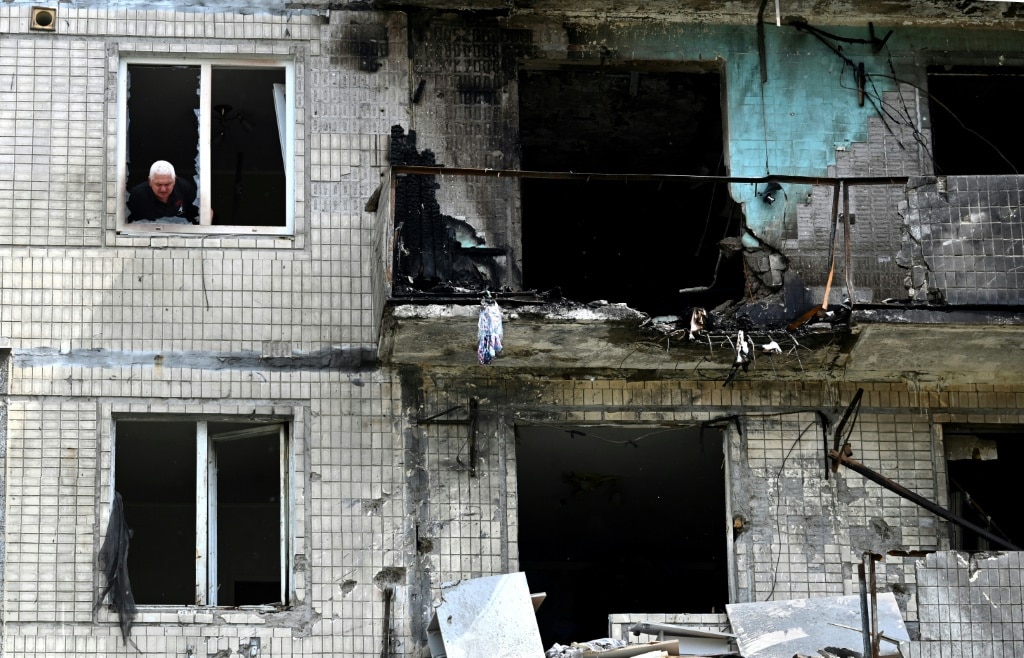Ukraine draws on electronic curtain to fight killer drones
Harnessing rapidly evolving technology is key to resisting Russia as war in Ukraine is increasingly fought by remote control and artificial intelligence.
In his underground bunker, the Ukrainian commander points at a red dot moving fast across a green circle on his screen. Set apart from a cluster of blue and red markers representing friendly and hostile drones hovering in the air near by, this one is flying straight at us.
“We have a device here that can intercept the operator’s video feed, so we can record one of his flights and broadcast it to him during his next one,” says the commander, Captain “Coffee”.
“He’ll think he is still flying while we have already downed his drone and are triangulating his location,” he says.
“By the time he realises and changes frequencies, we will have already sent our little plane to see where he is and strike him,” the captain adds with a grin. “We used to transmit porn films to the enemy pilot’s feed as a distraction, but that gave us away too quickly.”

On this occasion the “enemy”, a Ukrainian student drone pilot who has not registered his flight with the captain, is let off with only his aircraft brought down. Coffee, 43, heads the radioelectronic warfare department at the Specialised School for Unmanned Aerial Vehicle Systems and Radioelectronic Warfare. The airfield and its bunkers serve as his classroom.
A Ukrainian military intelligence estimate shared with The Times suggests that 80 per cent of the Russian casualties and equipment losses in the past year were inflicted by drones. The Russians, too, have learnt that drones are the most cost-effective way to kill. President Putin’s men are now using them to devastating effect on Ukrainian supply lines, helping them to inch forward in the Donbas and along the northern border with the Sumy region.
As drones replace guns as the primary weapons of warfare, the ability to interfere with their work is increasingly vital. Coffee is charged with imparting to yesterday’s riflemen, gunners and tank drivers an intimate knowledge of the rapidly evolving technology that can save their lives on the battlefield. His academy is also the final testing ground for the latest Ukrainian electronic warfare devices before they are dispatched to the front line.
Among them are the Azimuth radio tracking station, which follows drones using their radio signals, and the Mirage, which jams them. Kvertus, the Ukrainian company that builds both systems, is working with the defence ministry on Atlas, a plan to create a radioelectronic wall along 1300km of the front line, deploying 260 Azimuths that can track targets within 30km and 5600 Mirages that can jam drones up to 5km away.
Brave One, a military initiative of the Ukrainian government, is seeking £90 million ($189m) to help Kvertus build the wall. Kvertus says it has deployed hundreds of the systems to the front line as well as thousands of other electronic measures such as drone guns, vehicle-mounted jammers and personal jamming backpacks. “Over these three years, we’ve sold, I believe, about 40,000 units,” says Oleksii Cherniuk, Kvertus’s operations director.

The Mirage jammers can work in three modes, he says, the first controlled by a soldier using a tablet. The second allows it to be controlled through the internet from anywhere, and the third is autonomous, automatically shutting down targets identified by the Azimuth tracker.
Lieutenant Andriy “Danube” Bezsonov, the electronic warfare and electronic countermeasures service leader of the 18th Brigade of the National Guard of Ukraine, is using them on the battlefield. “We’ve had the main components of the Atlas system for a few months and they’ve already shown their effectiveness,” says Bezsonov, 45.
Even as the project gets under way, complications have arisen. The Russians have pioneered kamikaze drones controlled by fibre-optic cable that are impervious to jamming and give off no radio signal. Often, fibre-optic drones are used to take out electronic warfare stations, allowing radio-controlled counterparts with longer ranges to penetrate Ukrainian lines.

Nor do the systems bring down GPS-guided munitions, such as Russia’s long-range Shahed drones, which do not need to transmit video, instead receiving their targeting co-ordinates by satellite through an antenna with eight sensors, all of which need to be defeated to stop it. Over the past week, Moscow has massed waves of hundreds of Shaheds against Ukrainian cities. At the front, the latest threat is drones controlled by AI, which lock on to their targets more than a kilometre away.
It leaves electronic warfare specialists scrambling to keep up. Kvertus is developing a system, Vepr, that it says it has tested successfully against the Shahed antenna and will deploy it to complement Atlas. Bezsonov says: “We are developing with crazy speed. On one hand it’s good. On the other hand, it’s difficult, because radioelectronic warfare is not just a matter of giving an infantry man a Kalashnikov assault rifle and asking him to shoot. We don’t have enough specialists.”

This is where Coffee comes in. In 24 days, the captain tries to relay the principles of radioelectronic warfare he has learnt over six years. Yet battlefield commanders send soldiers to him without any real selection process, he complains, joking that one private was sent to him as the battalion drone expert because he had knocked down a Russian reconnaissance drone stuck in a tree with a stick. “Only two in ten will make it through the course to become operators,” he says. “The rest, well … if they can’t defend their unit properly, it’s better for them to remain riflemen.”
The Times






To join the conversation, please log in. Don't have an account? Register
Join the conversation, you are commenting as Logout